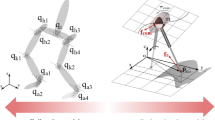Abstract
Statically stable walking locomotion research has focused mainly on robot design and gait generation. However, there is a need to expand robots’ capabilities so that walking machines can accomplish the kinds of real tasks for which they are eminently suited. Many such tasks demand trajectory tracking, but researchers have traditionally ignored this subject. This article focuses on the tracking of predefined trajectories with hexapod robots walking on natural terrain with forbidden zones. The method presented herein, which relies on gait algorithms defined elsewhere, describes certain localization strategies and control techniques that have been employed to follow trajectories accurately and have been implemented in a real walking hexapod. Several experimental examples are included to assess the proposed algorithms.
Similar content being viewed by others
Explore related subjects
Discover the latest articles, news and stories from top researchers in related subjects.References
Acar, E., & Choset, H. (2001). Robust sensor-based coverage of unstructured environments. In Proceedings of the international conference on intelligent robots and systems, Maui, Hawaii, pp. 61–68.
Bai, S., & Low, K. H. (2001). Body trajectory generation for legged locomotion systems using a terrain evaluation approach. In Proceedings of the 2001 IEEE international conference on robotics and automation, Seoul, Korea, May 21–26, pp. 2279–2284.
Catalbiano, D., Muscato, G., & Russo, F. (2004). Localization and self calibration of a robot for volcano exploration. In Proc. IEEE int. conf. on robotics and automation, pp. 586–591. New Orleans, LA.
Choset, H., & Pignon, P. (1997). Coverage path planning: the boustrophedon cellular decomposition. In Proceedings of the international conference on field and service robotics, Canberra, Australia.
Cobano, J. A. (2007). Localization and trajectory tracking with walking robots in natural environments. Ph.D. Thesis, University Complutense of Madrid.
Cobano, J. A., Estremera, J., & Gonzalez de Santos, P. (2008). Location of legged robots in outdoor environment. Robotics and Autonomous Systems, 56, 751–761.
Estremera, J., & Gonzalez de Santos, P. (2002). Free gaits for quadruped robots over irregular terrain. The International Journal of Robotics Research, 21(2), 115–130.
Estremera, J., & Gonzalez de Santos, P. (2005). Generating continuous free crab gaits for quadruped robots on irregular terrain. IEEE Transactions on Robotics, 21(6), 1067–1076.
Estremera, J., Cobano, J. A., & Gonzalez de Santos, P. (2010, in press). Continuous free-crab gaits for hexapod robots on natural terrain with forbidden zones: an application to humanitarian demining. Robotics and Autonomous Systems. doi:10.1016/j.robot.2009.11.004
Garcia, E., & Gonzalez de Santos, P. (2004). Mobile robot navigation with complete coverage of unstructured environments. Robotics and Autonomous Systems, 46(4), 195–204.
Gassmann, B., Zacharias, F., Zöllner, J. M., & Dillmann, R. (2005). Localization of walking robots. In Proceedings of the 2005 IEEE, international conference on robotics and automation, pp. 1483–1488. Barcelona, Spain.
Gelb, A., Kasper, Jr., J. F., Nash, Jr., R. A., Price, C. F., & Sutherland, Jr., A. A. (1986). Applied optimal estimation. Cambridge: MIT.
Gonzalez de Santos, P., & Jimenez, M. A. (1995a). Generation of discontinuous gaits for quadruped walking machines. Journal of Robotic Systems, 12(9), 599–611.
Gonzalez de Santos, P., & Jimenez, M. A. (1995b). Path tracking with quadruped walking machines using discontinuous gaits. Computers and Electrical Engineering, 21(6), 382–396.
Gonzalez de Santos, P., Cobano, J. A., Garcia, E., Estremera, J., & Armada, M. A. (2007). A six-legged-robot based system for humanitarian demining missions. Mechatronics, 17, 417–430.
Kalman, R. E. (1960). A new approach to linear filtering and prediction problems. Transaction of the ASME-Journal of Basic Engineering, 82, 35–45.
Lee, J. K., & Song, S. M. (1990). Path planning and gait of walking machine in an obstacle-strewn environment. Journal of Robotic Systems, 12(3), 801–827.
Longo, D., Muscato, G., & Sacco, V. (2002). Localization using fuzzy and Kalman filtering data fusion. In Proc. int. conf. climbing and walking robots, Paris, France.
Molfino, R., Armada, M., Cepolina, F., & Zoppi, M. (2005). ROBOCLIMBER the 3 ton spider. Industrial Robot, 32(2), 163–170.
Orin, D. (1982). Supervisory control of a multilegged robot. The International Journal of Robotic Research, 1(1), 79–91.
Roumeliotis, S. I., & Bekey, G. A. (1997). An extended Kalman filter for frequent local and infrequent global sensor data fusion. In Proceedings of the SPIE (sensor fusion and decentralized control in autonomous robotic systems), pp. 11–22. Pittsburgh, Pennsylvania.
SILO-6 (2008a). The SILO-6 and DYLEMA Projects’ Home Page. Available at: http://www.iai.csic.es/users/silo6/.
SILO-6 (2008b). The SILO-6 and DYLEMA Projects’ videos. Available at http://www.iai.csic.es/users/silo6/SILO6_pics/SILO6TrajectoryGPSx10.wmv.
Welch, G., & Bishop, G. (2004). An introduction to the Kalman filter. Department of Computer Science, University of North Carolina, Chapel Hill.
Zhang, F. (2007). Curve tracking control for legged locomotion. In Proceedings of the 2007 American control conference, New York, NY, July 11–13, pp. 2836–2841.
Author information
Authors and Affiliations
Corresponding author
Rights and permissions
About this article
Cite this article
Cobano, J.A., Estremera, J. & Gonzalez de Santos, P. Accurate tracking of legged robots on natural terrain. Auton Robot 28, 231–244 (2010). https://doi.org/10.1007/s10514-009-9165-4
Received:
Accepted:
Published:
Issue Date:
DOI: https://doi.org/10.1007/s10514-009-9165-4




